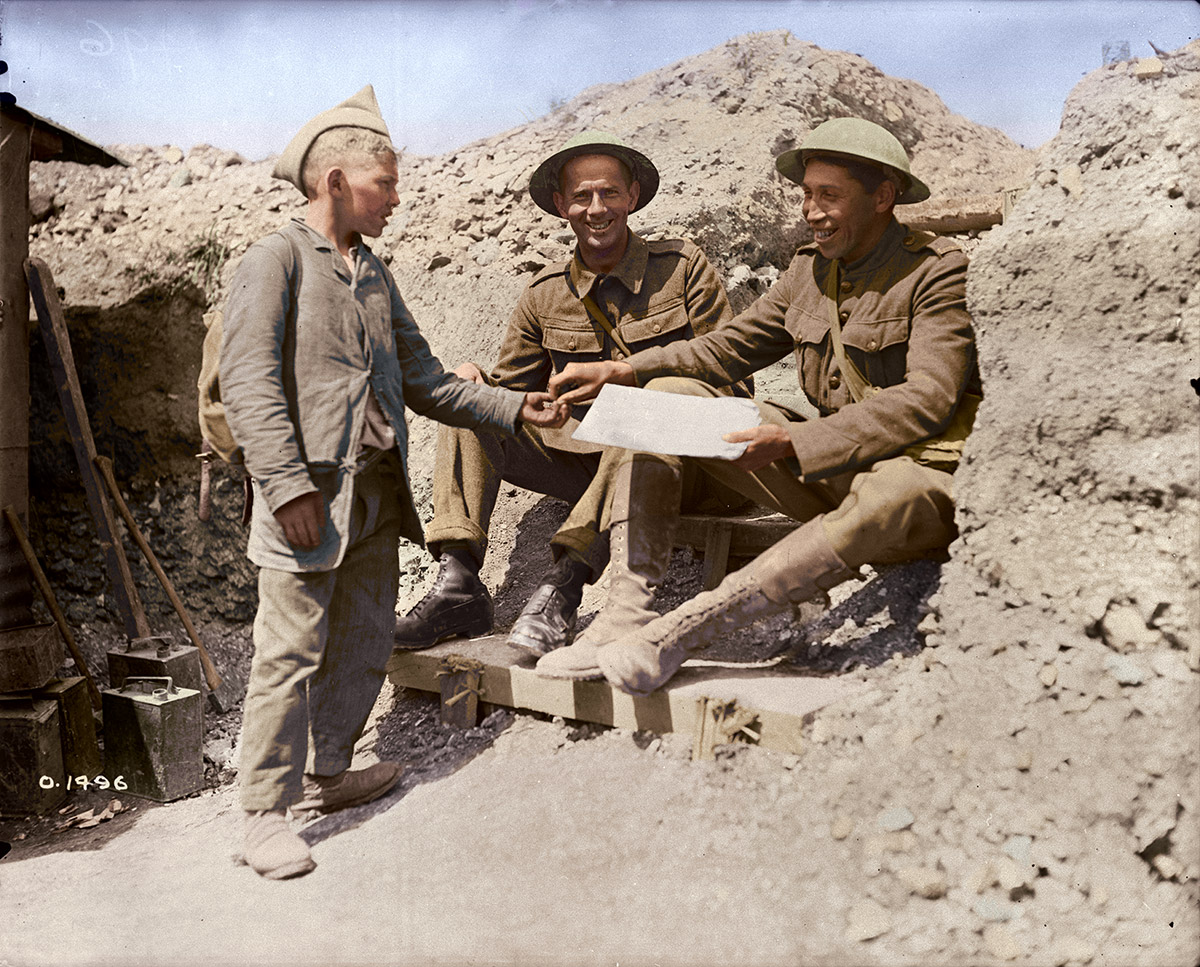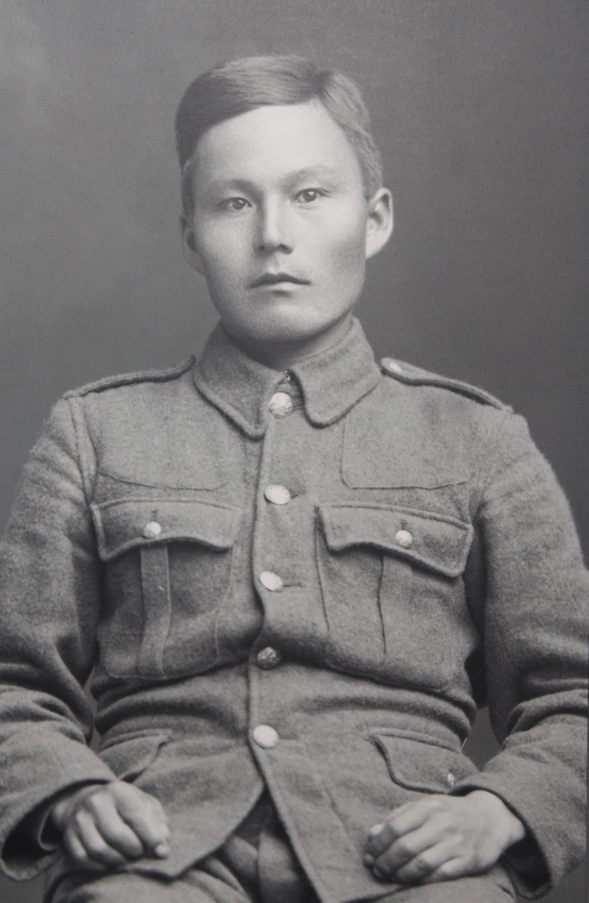Indigenous soldiers, nurses, and ordinary civilians made a major contribution to Canada’s First World War effort. More than 4,000 First Nations soldiers fought for Canada during the war, officially recorded by the Department of Indian Affairs (see Federal Departments of Indigenous and Northern Affairs). In addition, thousands more non-Status Indians, Inuit, and Métis soldiers enlisted without official recognition of their Indigenous identity. More than 50 Indigenous soldiers were decorated for bravery in action, including the Anishinaabe (Ojibwe) soldier Francis Pegahmagabow, Inuit soldier John Shiwak, and Cree soldier Henry Norwest.
First World War, 1914–18
During the First World War, the story of the First Nations, particularly Status Indians, is the best known. By contrast, little is known of Métis military service because a person’s ethnicity was not listed on enlistment papers, and no government department oversaw Métis populations to provide a paper trail. Similarly, only a few Inuit served, mostly in the Royal Newfoundland Regiment, which was not part of the Canadian Expeditionary Force.

Recruitment and Conscription
The story of the recruiting and conscription of Indigenous men during the First World War is complex and still debated by historians. Between August 1914 and December 1915, relatively few First Nations men volunteered, as the army was hesitant about recruiting them for fear the “Germans might refuse to extend to them the privileges of civilized warfare.” This was not a rigid policy, and at least 200 did manage to enlist. After December 1915, the British government asked its Dominions to actively recruit Indigenous soldiers, and this led to more vigorous recruiting on reserves.
The enactment of conscription in 1917, which included Status Indians, sparked great protest from First Nations peoples (see Military Service Act). In response, the government granted a limited exemption from overseas combat service for Status Indians in January 1918.
By war’s end, Indian Affairs estimated 4,000 First Nations men enlisted, but their records were incomplete and omitted non-Status Indians and Métis people. While speculative, the total figure for 1914-18 could have been closer to 6,000, with more recent research pushing the number even higher. Historians estimate that 35 per cent of the Status Indian population of military age voluntarily enlisted for overseas service, comparable to the percentage of non-Indigenous men who volunteered for duty.
Did you know?
According to Yann Castelnot, an amateur historian based in Quebec, more than 6,500 Indigenous persons served in the Canadian armed forces during the First World War. For more than 20 years, Castelnot researched Indigenous men and women that have served with British, French, Canadian and American forces since the 17th century. As of May 2018, he had identified more than 154,000 individuals, including about 19,000 that served with Canadian forces.

Soldiers' Experience
Some regiments boasted large numbers of Indigenous soldiers, including the 114th Battalion ("Brock's Rangers") and the 107th “Timber Wolf” Battalion. However, Indigenous soldiers were mostly integrated into regular military units, rather than serving in segregated “all-Indian” units. This meant that Indigenous and non-Indigenous soldiers interacted to a degree not experienced in pre-war Canada. For some, the culture shock of transitioning to military life and discipline proved difficult, and those who disobeyed army regulations were disciplined or even discharged. However, the vast majority of Indigenous recruits became successful soldiers, with at least 37 decorated for bravery in action. A number of Indigenous soldiers achieved fame as snipers, most notably Francis Pegahmagabow, an Anishinaabe from the Parry Island reserve, credited with about 378 kills, and Cree Henry Norwest, with 115 official kills. Most Indigenous veterans’ accounts speak of how their fellow soldiers accepted and respected them — racial prejudice had no place in the trenches.

Home Front
Across Canada, Inuit, Métis and First Nations experiences on the home front varied greatly. On most reserves across southern Canada, the conflict was a prominent factor in peoples’ lives. Many engaged vigorously in the war, with high enlistments, generous contributions to charitable and patriotic causes (almost $45,000 from band funds alone), and public support for the King, British Empire and national war effort. Along with this went diligent efforts to expand production from reserve agricultural lands and opportunities to participate in war-related work, which many Aboriginal people took on enthusiastically.
Despite such efforts, the federal government expropriated 313,398 acres of reserve lands and forced some bands to lease reserve land without their consent. Many First Nations felt mixed, indifferent or even hostile to contributing to the war, some because of a difficult past relationship with the government or because this was not their war. In more remote regions, Métis, Inuit and First Nations were insulated from global events and the war barely touched their daily lives.

Veterans and the Interwar Period
When the war ended in 1918, Indigenous soldiers returned alongside their comrades to what they hoped would be a better world, but these hopes would be disappointed. The marginal political, legal, economic and social position of Indigenous peoples was unaltered by the war or their contributions. First Nations veterans — because they were already government wards as Status Indians and viewed as “looked after” — found themselves largely shut out of benefits provided for returning soldiers. Doubly painful was the Soldier Settlement Act, meant to help soldiers begin farming. Not only was it almost impossible for Status Indians to qualify, but the government confiscated an additional 85,844 acres from reserves to provide for non-Indigenous soldiers under the plan. Métis and Inuit access to benefits remains a mystery.
Frustrated by the poor treatment of Indigenous peoples, Haudenosaunee veteran F.O. Loft a Mohawk of the Six Nations Grand River reserve, formed the League of Indians of Canada in 1919, advocating for the resolution of a set of grievances common to Indigenous peoples across Canada. The league eventually failed in the interwar period, due to difficulties in uniting geographically separated and ethnically, linguistically and religiously divided bands into a national Indigenous organization. The interwar years were characterised by profound social and governmental neglect of Indigenous populations, especially during the Great Depression of the 1930s.
Legacy and Growing Recognition
Despite their contributions to the national war effort, Indigenous veterans were largely forgotten in the decades after 1918, until they began to organize and campaign for recognition of their sacrifices and restitution for grievances over veterans benefits from the 1970s to the 2000s. Perseverance paid off, with a consensus report accepted by both First Nations veterans groups and the government in 2001, followed by an offer of a public apology and offer of compensation in 2003. Métis and Inuit veterans’ grievances have not received the same hearing.
In recent years, Indigenous veterans have gained much greater recognition in local and national acts of remembrance, including Indigenous Veterans Day on 8 November (inaugurated by Winnipeg’s city council in 1994) and a National Aboriginal Veterans Monument in Ottawa (unveiled in 2001). Notable Indigenous veterans of the First World War include Francis Pegahmagabow, John Shiwak, Henry Norwest, Tom Longboat, Joseph Benjamin Keeper, Alexander George Edwin Smith, David Kejick, Frederick Ogilvie Loft and Edith Monture.

 Share on Facebook
Share on Facebook Share on X
Share on X Share by Email
Share by Email Share on Google Classroom
Share on Google Classroom














